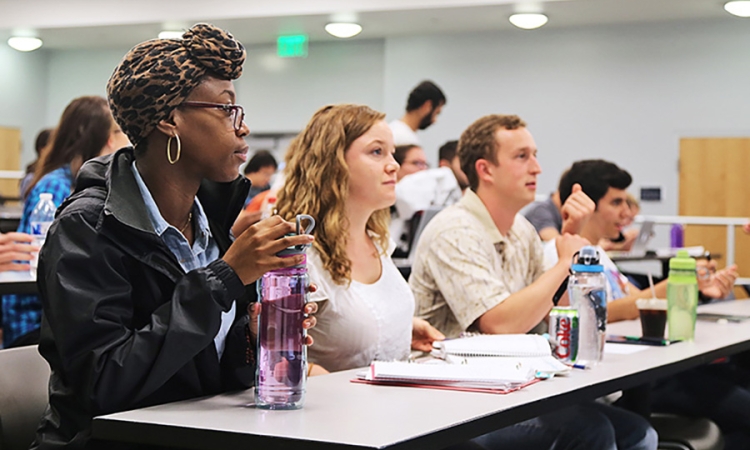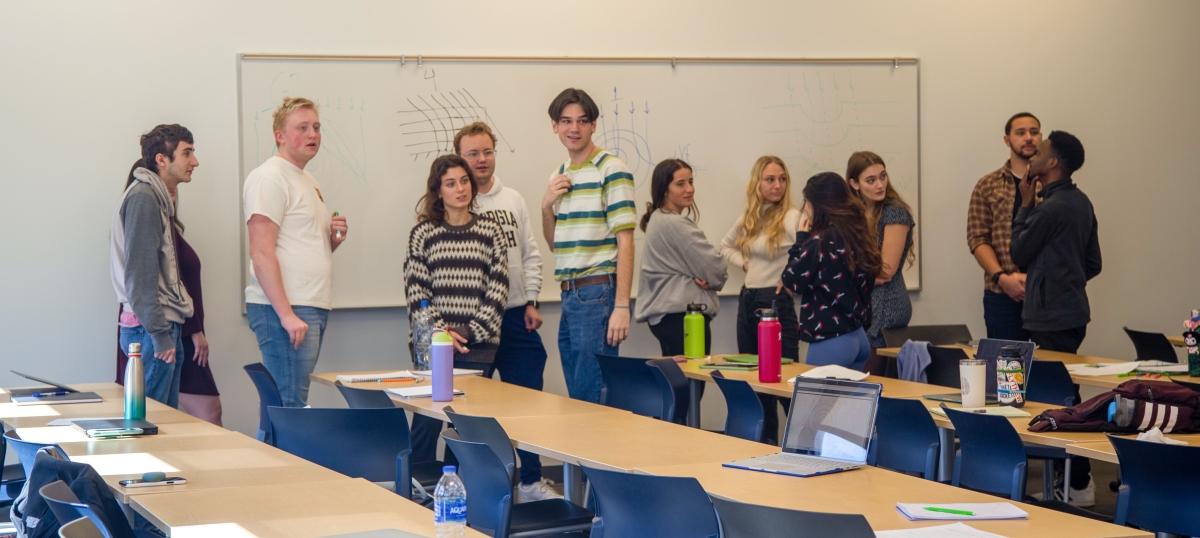
A group of students working collaboratively to determine how waves will interact with different coast lines in Kevin Haas's coastal engineering course. (Photo by Amelia Neumeister)
In September 2020, the School of Civil and Environmental Engineering began a five-year journey to radically rethink its model of engineering education.
Nearly three years later, CEE leaders are starting to see the fruits of their labor. The School is re-envisioning its engineering curriculum with the inclusion of data analytics, entrepreneurship and innovation, storytelling and reflection, and teamwork—skills that complement and strengthen traditional engineering coursework.
“We’re working to graduate holistic engineers with an entrepreneurial mindset,” said Frederick L. Olmsted Professor Adjo Amekudzi-Kennedy, Associate Chair for Global Engineering Leadership and Entrepreneurship. “In doing so, we expect to enhance the students’ efficacy and sense of belonging to the School and profession.”
Armed with a $1 million grant from the National Science Foundation’s RED program — which stands for Revolutionizing Engineering Departments—School leaders crafted a plan to revamp the curriculum with a focus on educating holistic engineers and instilling in students a greater sense of understanding and belonging to the civil and environmental engineering fields.
In 2021, the effort was bolstered by an additional grant from the Kern Family Foundation’s Kern Entrepreneurial Engineering Network (KEEN). CEE was one of four College of Engineering programs selected to receive funds to help students build an entrepreneurial mindset by infusing story-driven learning into their curricula. CEE is also incorporating value-sensitive design, problem-based learning, and teaming as part of the KEEN and RED initiatives.
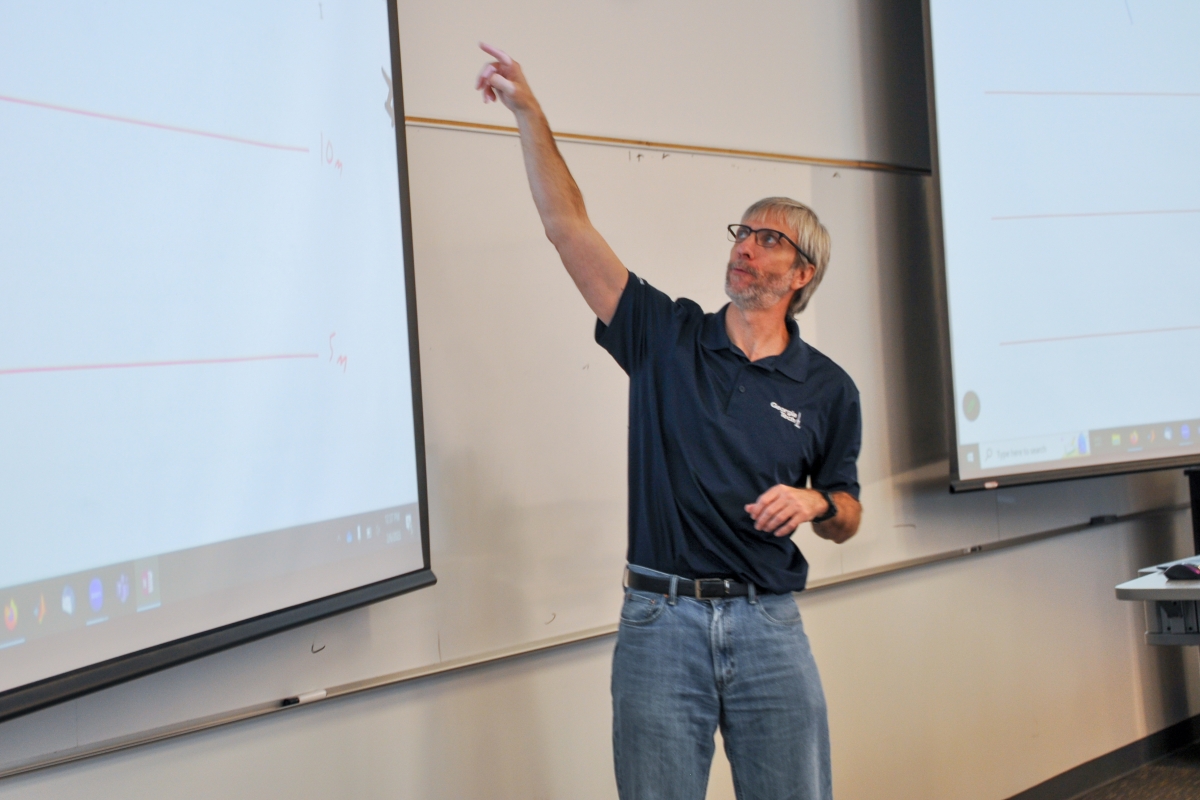
Professor Kevin Haas has developed his coastal engineering course using resources from the RED and KEEN initiatives. (Photo by Melissa Fralick)
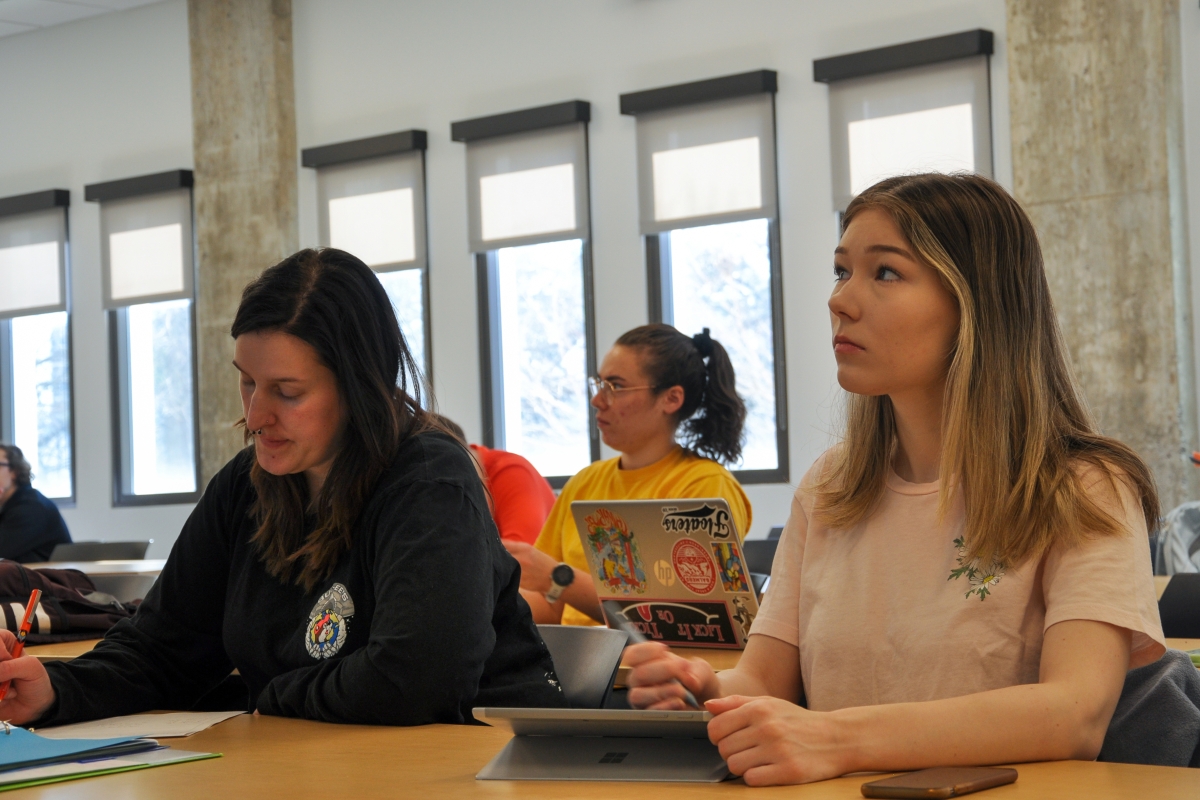
Students in the Professor Kevin Haas's coastal engineering course have participated in story-driven learning exercises. (Photo by Melissa Fralick)
(text and background only visible when logged in)
The centerpiece of the School’s effort is a spine of four courses that will anchor the undergraduate experience: Exploring CEE, which provides a broad overview of civil and environmental engineering topics; CEE Systems, a course on the study of the connections among infrastructure systems, sustainability and economics; Data Analytics in CEE Applications, in which students use emerging computational tools to enhance the study of civil and environmental engineering; and Capstone Design, a course for seniors to apply their knowledge to a semester-long design project.
The classes, taken over the course of four years, focus on interactive problem-based learning around the societal grand challenges that civil and environmental engineers work to decipher and solve. They feature elements of computational and team development, include reflective teaching and learning, and aim to create a greater sense of belonging within the School and the profession.
The School’s Academic Professionals, Lisa Rosenstein and Robert Simon, have designed learning environments across the spine of courses for students to develop their ability to work collaboratively and improve their written, oral, and visual communication skills.
“This spine of courses is where all students will have this common experience,” Amekudzi-Kennedy said. “The courses build upon each other and also relate to the rest of the curriculum.”
Developing these courses and integrating them into our curriculum is critically important to advancing the students’ cognitive, interpersonal and intrapersonal skill sets.
Don Webster, Karen and John Huff School Chair
Karen and John Huff School Chair Don Webster noted that these efforts are an important component of the School’s strategic plan.
“I am excited to see these courses come to life through these re-imagining efforts,” Webster said. “Developing these courses and integrating them into our curriculum is critically important to advancing the students’ cognitive, interpersonal and intrapersonal skill sets. We feel strongly that these courses will ultimately help to codify students’ identities as a civil engineer or an environmental engineer.”
Data-driven Engineering
Offered as a pilot course for the first time this spring, the third-year course, Data Analytics in CEE Applications, aims to equip students with literacy in emerging technologies in machine learning and artificial intelligence.
As these technologies evolve, they are being utilized more frequently within the study and practice of civil and environmental engineering. Students will find that there are many meaningful ways that engineers can use this computing technology to help analyze and address the grand challenges we face on a global scale—such as climate change, natural disasters, and infrastructure issues.
Frederick L. Olmsted Early Career Assistant Professor Jorge Macedo is the instructor for the new data analytics course. Macedo said he uses real-world examples to teach students how they can get insights into CEE problems of relevance by taking advantage of modern data science techniques.
For example, the class analyzed data from recent earthquakes in Turkey and Syria as well as measurements from rising sea levels.
“The tools that they are learning will equip them to actually make value of the data that is being collected these days,” Macedo said. “The idea is that they can take advantage of the many things that could be exploited from this booming area of data science.”
Early Engagement
Professor Kevin Haas, Associate Chair for Undergraduate Programs, teaches the first-year course, Exploring CEE. This course was born from a desire to help students determine what aspects of civil and environmental engineering they are passionate about, developing an early connection to the School.
In 2017, Haas conducted a Sankey diagram analysis to determine when CEE students enter and exit the program. What he found was that about half of students who initially declared civil or environmental engineering as their major transferred into a different major, many before they had taken any CEE courses.
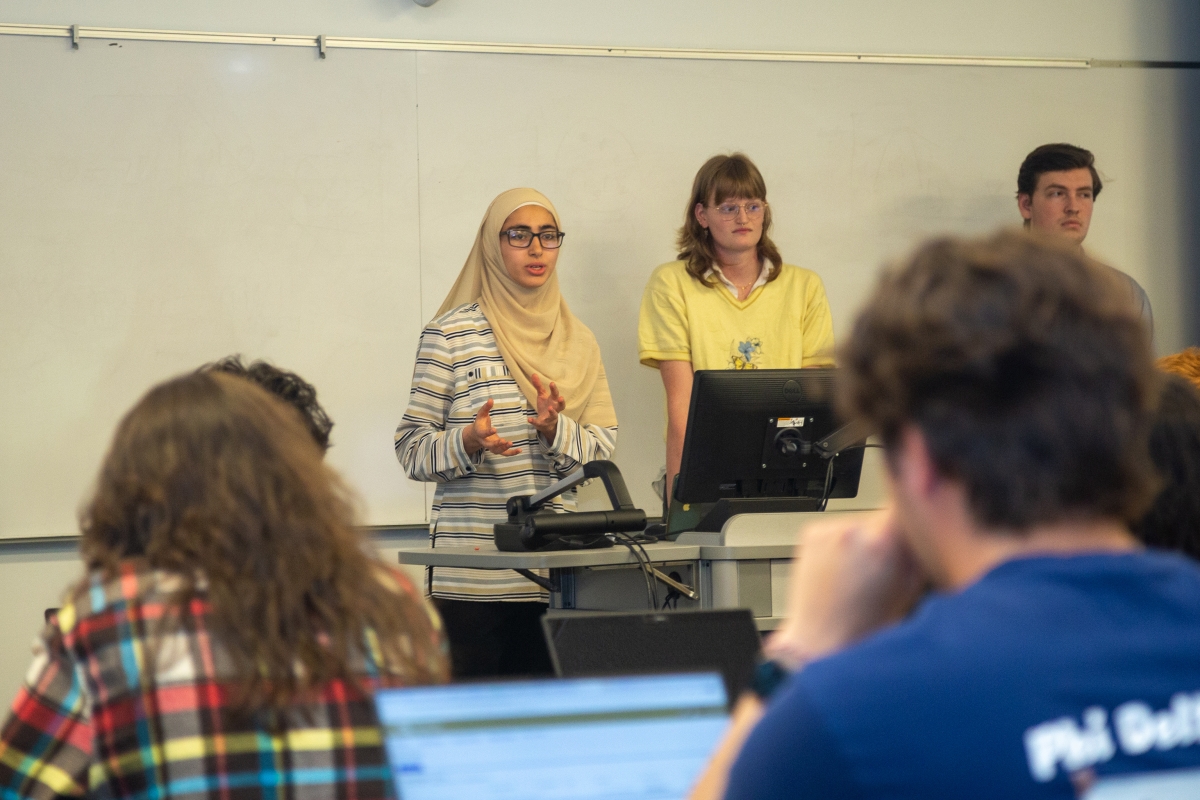
Students present a group project in Professor Adjo Amekudzi-Kennedy's Civil and Environmental Engineering Systems course. (Photo by Amelia Neumeister)
In parallel, about half of the civil or environmental engineering graduates originated in a different major before transferring into the School.
CEE leaders began to think about ways to address the attrition and concluded that early and continuing engagement in their major would help students to learn about exciting aspects of the discipline, help students create a stronger identity as a civil or environmental engineer, and help to foster a sense of belonging.
Exploring CEE was first offered in 2019 to introduce first-year students to the work civil and environmental engineers do through interdisciplinary research topics, guest lecturers, and team problem-solving exercises.
Over the last four years, Haas has seen a significant shift in the experience of first-year students who take the course. Of the 60 first-year students who took the course in fall 2022, only five changed their major. Over the course of the semester, Haas introduces students to the breadth of civil and environmental engineering topics through the School’s four cross-cutting research areas: Smart Cities, Sustainable Systems, Resilient Infrastructure, and Healthy Communities.
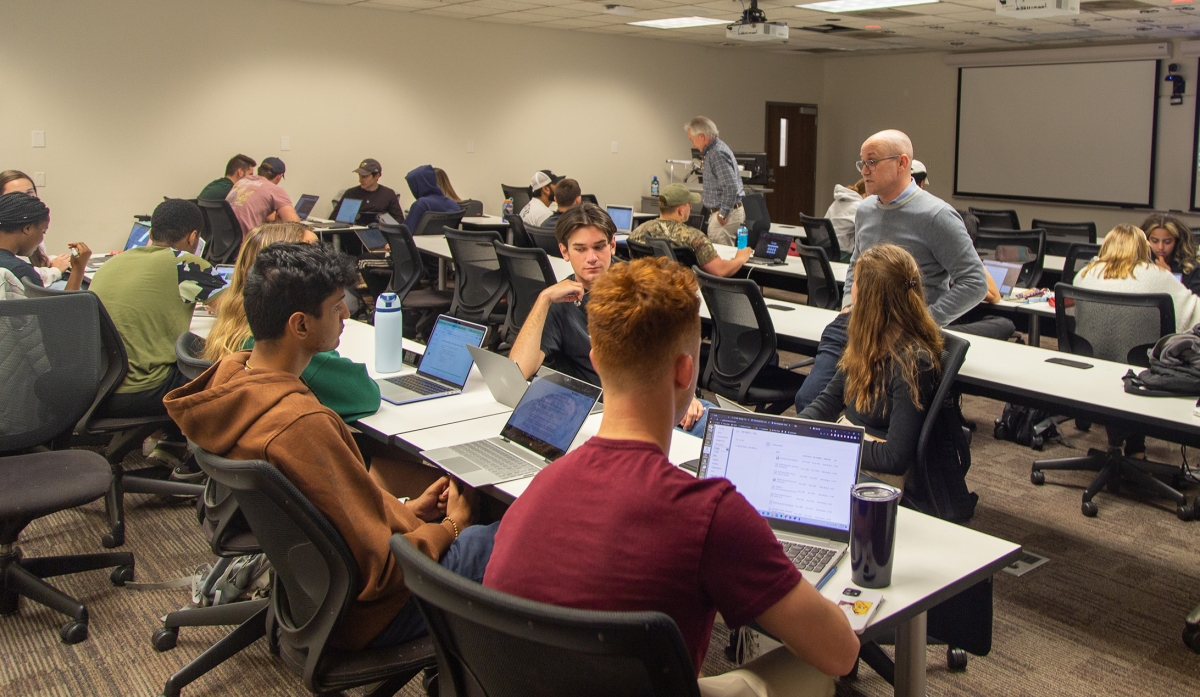
Teams of students talk through their entrepreneurial concepts with instructors as part of a course on innovation and entrepreneurship. (Photo by Amelia Neumeister)
Haas recalled a student whose experience illustrates the efficacy of the course. After learning about smart cities and transportation systems, she wrote in a reflection exercise that she didn’t think civil and environmental engineering was what she really wanted to do. But later in the semester, after the units on healthy communities and sustainable systems, she changed her mind.
“She found her passion,” Haas said. “She found where she belonged. So in the end, she did not change her major. She realized that being an environmental engineer was what she wanted to do after all.”
Haas said the broad range of topics and applications is one of the things that makes civil and environmental engineering so unique.
“I frequently see with the breadth of topics that we do, not everything will resonate with everybody. There will be topics that individual students are just not going to enjoy,” Haas said. “But there's enough variety that most students will find exactly what they are uniquely passionate about.”
Telling the Story
Through the RED and KEEN grants, professors like Haas and Amekudzi-Kennedy have had the opportunity to incorporate story-driven learning into their courses.
The grants have also enabled the School to hire Ellen Zerbe, a learning scientist, to support the change initiative through faculty development.
Amekudzi-Kennedy has found that her students benefit from taking time to digest and talk about what they’ve learned in individual or group video reflections or through the use of various online tools.
“I used to teach and go away. I don't do that anymore,” Amekudzi-Kennedy said. “When I finish teaching, I let the students reflect because I feel that's how it gets consolidated and integrated into that frame of reference, of knowledge that they are developing and I think they just come out differently. It's a higher quality of learning.”
Caroline Delcroix, a student in the Amekudzi-Kennedy’s CEE Systems course, said the reflection exercises have helped her develop her professional identity.
“I have found that I am able to better articulate what I want to do after just a few weeks in the class, and I am very grateful for that,” Delcroix said.
Haas said he uses story-driven learning in the Exploring CEE course to help first-year students develop their sense of self and learn skills like how to pivot when things don’t go according to plan.
“The end product is really to help them understand more about who they are, where they're going and what different options they have for their future,” Haas said.
Related Links
CEEatGT Awarded $1 Million Educational Grant
The School of Civil and Environmental Engineering has been awarded a $1 million grant from the National Science Foundation to develop innovative changes to the School’s curriculum and culture.
(text and background only visible when logged in)

